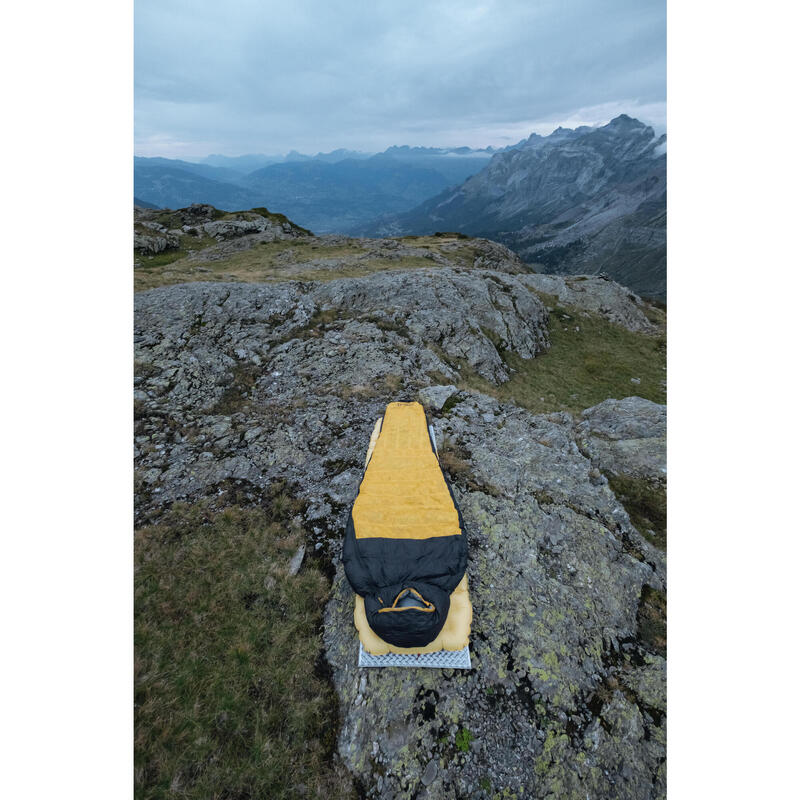Weight and dimensions of MT900 5°C Down sleeping bag (+/- 5% variation due to production tolerances).
Size S (user up to 1.59 m): 670 g (including 280 g down/feathers). Folded size: L 27 cm Ø 15 cm. Volume 4.7 L
Size M (user between 1.60 m and 1.69 m): 750 g (including 322 g down/feathers). Folded size: L 27 cm Ø 16 cm. Volume 5.5 L.
Size L (user between 1.70 m and 1.84 m): 830 g (including 370 g down/feathers). Folded size: L 27 cm Ø 17 cm. Volume 6.2 L.
Size XL (user between 1.85 m and 2m): 930 g (including 420 g down/feathers). Folded size: L 31 cm Ø 18 cm. Volume 6.9 L.
What are the features of the MT900 5°C Duvet sleeping bag?
Anatomically shaped hood with drawcord.
YKK double-slider zip, equipped with an anti-pinch system, for optimum ventilation.
Anti-cold flap along the zip to prevent heat loss.
Inside zipped pocket.
2 loops at the foot of the bag for hanging for ventilation or drying.
Comes with a perforated fabric storage bag.
What is the fabric strength of the MT900 5°C Duvet sleeping bag?
On the outside, the fabric is 100% polyamide 20g/m2 in 10 denier and Ripstop 30 denier. This fabric withstands 80,000 abrasion cycles.
Resistance is calculated using the martindale test (Standard 12 947-2). This test consists of rubbing the bag material against another material to determine the wear limits of the product.
Inside, the lining uses a 100% polyamide 35 g/m2, 20 denier fabric.
How do you stay warm in the MT900 5°C Duvet sleeping bag?
Dress simply (1 layer of clothing, ideally merino wool, is enough).
Protect your extremities with a hat, gloves, socks and warmers if necessary.
Use a sleeping bag sheet to optimize warmth and avoid over-washing your sleeping bag. Choose a mattress with good insulation (R-value > 3).
And a little tip: contract your muscles (70% of the energy consumed is transformed into heat), but without making any movement that generates cold draughts!
How to care for your MT900 5°C Duvet sleeping bag?
Even if you regularly use a bag sheet, you'll need to wash your down bag from time to time. You'll find all the information you need on the Conseil Sport website at Decathlon.
In brief:
1/ Machine wash, 30°, with 2 or 3 tennis balls. Spin gently.
Use special down detergent (ref: 8609821)
2/ Tumble-dry with 2 or 3 tennis balls, repeating 2 or 3 times until completely dry.
How to repair your MT900 5°C Duvet sleeping bag?
On a trek, a tear in your sleeping bag can happen! The good news is that it can be repaired to prevent the tear from getting bigger or the synthetic fibers from escaping.
We recommend the use of self-adhesive repair patches (ref: 8584596).
And if you don't feel comfortable performing this operation, an iron-on patch installation service is available in your Decathlon store.
What is comfort temperature?
All our sleeping bags feature comfort temperatures tested by an independent laboratory (AITEX) in accordance with European standard ISO 23537-1:2022.
Comfort temperature is the lower limit of comfort at which a person in a relaxed posture is in overall thermal equilibrium and neither cold nor hot (determined for a standard woman and under normal conditions of use).
Choose your sleeping bag according to this temperature.
And what is the comfort limit temperature?
The comfort temperature limit is the temperature at which a person curled up in a sleeping bag is in overall thermal equilibrium and neither cold nor hot (determined for a man and under normal conditions of use).
An important clarification concerning ISO 23537-1
For the purposes of this standard, the protocol for measuring the thermal performance of a sleeping bag uses a mattress whose thermal resistance corresponds to an R-value of 4.8.
This means that if you use a less insulating mattress, the thermal performance of your sleeping bag will be lower.
We therefore advise you to use an insulating mattress to optimize your thermal comfort.







